Timber Creek Florida Bourbon Review
By Elizabeth Emmons
Rating: B+

(Credit: Elizabeth Emmons)
Timber Creek was founded in May 2014, and sits near Destin, FL, a pretty city along Florida’s Emerald Coast, by Aaron Barnes and Camden Ford. Barnes and Ford were neighbors who bonded over their love of beer and quality ingredients, and they set up shop in (1,400-acre) backyard of one of their parents’ property in Crestview, about 45 minutes from Destin’s beaches.
For a distillery that is quite new to the scene, it has a wide range of spirits and solid production capacity, able to turn out one thousand cases of spirit per month. Timber Creek pays great attention to the ingredients that go into each bottle, sourcing the cane molasses from the Gulf Coast in nearby Louisiana for their rums, buying local fruits (blueberries, strawberries, peaches, muscadine grapes and plums) for their upcoming brandies, cold water extracting coffee beans (essentially the cold brew coffee technique which results in a coffee concentrate, producing maximum flavor) from Brazil, and using local water from the Florida aquifer system which has been filtered through hundreds of feet of soil and limestone. Last, but definitely not least, the grains, which are 95% Florida grown, showing a real dedication to the Sunshine State.
What I found most interesting about Timber Creek’s process is what they call a “gentle approach” with the grain during the distilling processes. This approach entails cracking the grains with a roller mill and then separating the tannic husks of the grain from the liquid in the lauter tun (the machine in which wort is separated from the grain), which is different from what many distilleries. Most often, the method is to crush the grain and the husks together into a flour which can result in a more tannic, and subsequently bitter and sometimes off-flavor. Barnes and Ford felt that by processing their grain this way, they could exercise more control over the taste and produce a whiskey with purer flavors, as they could remove the husks entirely from the mixture.
The Bourbon
The Bourbon release is a rich copper hue, with legs that drip (mostly evenly spaced) along the side of the glass.
When nosed, the whiskey yields essences of molasses, light bright wood and pear. It is a very clean and light, reminding me of men’s cologne or aftershave (in the sense of the brightness than the smell itself). On a viscosity scale, 1 being lowest and 10 the highest, I would place this one at a 6.
The whiskey is lightly spicy upfront, following through on the nose with bright wood and subtle char making itself known about 5 seconds in if you let it rest in your mouth. It has a smooth middle and finish, progressively getting drier and drier at the tail end. The mouthfeel of this is a little oily, and is in line with my viscosity scale rating. This whisky is a mixture of corn, wheat and barley and I would say that not one of those distinct grains takes over; it tastes like a pretty balanced blend.
I added a few drops of water to the half inch left in my glass and the water, as is the trend with whiskies that are young and woody, enhanced the oakiness and char. I prefer it without the water because I feel that it allows the whisky to have more facets of flavor.
Aaron Barnes was quoted that his products “just taste good”, and while I can’t vouch for every product at the Timber Creek, I’ll have to agree with him for his original Bourbon release. It is tasty and smooth, very easy to do drink, and while it does taste young and woody, it is not overpowered by that woodiness as I find some young whiskies are. Perhaps this smoothness can be attributed to Timber Creek’s gentle touch with the grains? Who knows, but for Florida’s first bourbon, I am impressed.
The Price
Timber Creek Florida Bourbon retails for $37 a bottle.




I am enjoying this bourbon more and more over time. It really grows on you… especially if you are a fan of wheated bourbons. I agree that a B+ is appropriate, but I think in time these guys will be cranking out A+ products. They are small scale enough to do everything top notch and change their process midstream if needed. The future is bright!